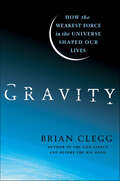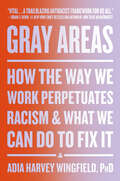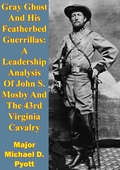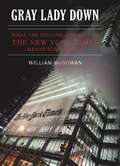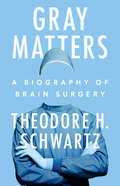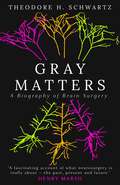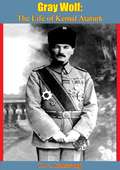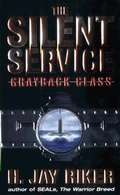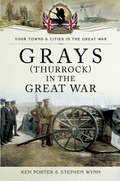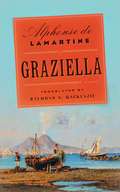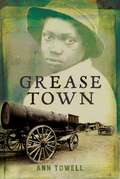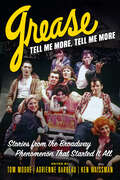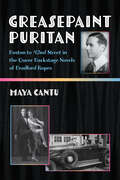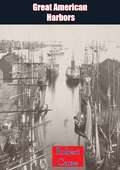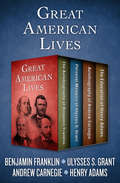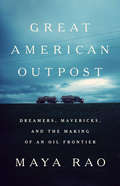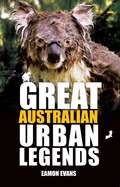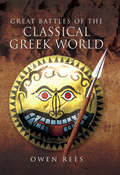- Table View
- List View
Gravity: How the Weakest Force in the Universe Shaped Our Lives
by Brian CleggA history of gravity, and a study of its importance and relevance to our lives, as well as its influence on other areas of science.Physicists will tell you that four forces control the universe. Of these, gravity may be the most obvious, but it is also the most mysterious. Newton managed to predict the force of gravity but couldn’t explain how it worked at a distance. Einstein picked up on the simple premise that gravity and acceleration are interchangeable to devise his mind-bending general relativity, showing how matter warps space and time. Not only did this explain how gravity worked—and how apparently simple gravitation has four separate components—but it predicted everything from black holes to gravity’s effect on time. Whether it’s the reality of anti-gravity or the unexpected discovery that a ball and a laser beam drop at the same rate, gravity is the force that fascinates.
Gravity’s Century: From Einstein’s Eclipse to Images of Black Holes
by Ron CowenRon Cowen offers a sweeping account of the century of experimentation that has consistently confirmed Einstein’s general theory of relativity. He shows how we got from Eddington’s pivotal observations of the 1919 eclipse to the Event Horizon Telescope, aimed at starlight wrapping around the black hole at our galaxy’s center.
Gray Areas: How the Way We Work Perpetuates Racism and What We Can Do to Fix It
by Adia Harvey WingfieldGray Areas has descriptive copy which is not yet available from the Publisher.
Gray Ghost And His Featherbed Guerrillas: A Leadership Analysis Of John S. Mosby And The 43rd Virginia Cavalry
by Major Michael D. PyottJohn Singleton Mosby led a successful partisan campaign during the American Civil War for the Confederacy. Prior to the war, Mosby was a frail nondescript lawyer. Entering the war as a private; Mosby eventually rose to the rank of Colonel. He organized, trained, and equipped the 43rd Virginia Cavalry, better known as Mosby's Rangers. This unit grew from nine men to almost nine hundred at the war's end, and conducted many daring celebrated raids on the Union forces and their supply lines. In addition to his raids Mosby provided accurate and timely intelligence to Major General J. E. B. Stuart and General Robert E. Lee throughout his service. This study is a leadership analysis of John Singleton Mosby using the U.S. Army's Field Manual 22-1 00, Army Leadership. The study examines Mosby's leadership development and evaluates him against the sixteen leadership dimensions that the Army currently uses to evaluate potential officers. The purpose of this study is to determine what leadership qualities Mosby possessed that contributed to his success. The study concludes that Mosby was able to influence subordinates, peers, superiors, and non-combatants; he provided a purpose and gave them direction and motivation; he also continuously sought ways to improve and expand the organization.
Gray Lady Down
by William McgowanThe New York Times was once considered the gold standard in American journalism and the most trusted news organization in America. Today, it is generally understood to be a vehicle for politically correct ideologies, tattered liberal pieties, and a repeated victim of journalistic scandal and institutional embarrassment.In Gray Lady Down, the hard-hitting follow up to Coloring the News, William McGowan asks who is responsible for squandering the finest legacy in American journalism. Combining original reporting, critical assessment and analysis, McGowan exposes the Times' obsessions with diversity, "soft" pop cultural news, and countercultural Vietnam-era attitudinizing, and reveals how these trends have set America's most important news icon at odds with its journalistic mission-and with the values and perspectives of much of mainstream America.Gray Lady Down considers the consequences-for the Times, for the media, and, most important, for American society and its political processes at this fraught moment in our nation's history. In this highly volatile media environment, the fate of the Times may portend the future of the fourth estate.
Gray Matters: A Biography of Brain Surgery
by Theodore H. Schwartz&“If you are at all curious about the brain or the surgeons who operate on it, Gray Matters is a must read and Dr. Theodore Schwartz is the perfect guide, a master brain surgeon and superbly talented writer. I have not read a better biography of our shared profession, and in Schwartz's talented hands, the most enigmatic 3 1/2 pounds of tissue in the known universe comes to light in remarkable and revelatory ways.&”—Dr. Sanjay Gupta, CNN Chief Medical Correspondent, and New York Times and #1 Wall Street Journal bestselling author of Keep Sharp: Build a Better Brain at Any AgeA popular biography of brain surgery, by one of its preeminent practitionersWe&’ve all heard the phrase &“it&’s not brain surgery.&” But what exactly is brain surgery? It&’s a profession that is barely a hundred years old and profoundly connects two human beings, but few know how it works, or its history. How did early neurosurgeons come to understand the human brain—an extraordinarily complex organ that controls everything we do, and yet at only three pounds is so fragile? And how did this incredibly challenging and lifesaving specialty emerge? In this warm, rigorous, and deeply insightful book, Dr. Theodore H. Schwartz explores what it&’s like to hold the scalpel, wield the drill, extract a tumor, fix a bullet hole, and remove a blood clot—when every second can mean life or death. Drawing from the author&’s own cases, plus media, sports, and government archives, this seminal work delves into all the brain-related topics that have long-consumed public curiosity, like what really happened to JFK, President Biden&’s brain surgery, and the NFL&’s management of CTE. Dr. Schwartz also surveys the field&’s latest incredible advances and discusses the philosophical questions of the unity of the self and the existence of free will. A neurosurgeon as well as a professor of neurosurgery at Weill Cornell Medicine, one of the busiest and most highly ranked neurosurgery centers in the world, Dr. Schwartz tells this story like no one else could. Told through anecdote and clear explanation, this is the ultimate cultural and scientific history of a literally mind-blowing human endeavor, one that cuts to the core of who we are.
Gray Matters: A Biography of Brain Surgery
by Theodore Schwartz&‘A fascinating and wide-ranging account of what neurosurgery is really about – the past, present and future.&’ Henry Marsh, author of Do No Harm Since its inception in the early twentieth century, brain surgery has maintained an air of mystery. As the saying &‘it&’s not exactly brain surgery&’ suggests, the specialty has become synonymous with a level of complexity and meticulousness rivalled only by, well, rocket science. Warm, rigorous and deeply insightful, neurosurgeon Theodore Schwartz reveals what it&’s really like to get inside someone&’s head – where every second can mean the difference between life or death. Drawing from Schwartz&’s experience in one of New York&’s busiest hospitals, Gray Matters explores the short but storied history of brain surgery. From the dark days of the lobotomy to the latest research into the long-term effects of contact sports on athletes&’ cerebral health, Schwartz unfolds the fascinating story of how we came to understand this extraordinary, three-pound organ, which not only keeps us alive, but makes us who we are.
Gray Wolf: The Life of Kemal Ataturk (Select Bibliographies Reprint Ser.)
by H. C. ArmstrongMUSTAPHA KEMAL ATATURK, the great Turkish dictator, is a figure of great significance to the modern world. He did in Turkey what, in effect, Nasser and the other present-day “strong men” are trying to do in their countries, and he is their model and ideal. In fact, Nasser said of this book specifically “This has been the most important book in my life.”Besides being of great historical importance, this book, first published in 1933, is also a fascinating study of an extremely complex and controversial figure, in which an iron self-discipline and a sudden capacity for self-abandonment existed side by side and indeed reinforced each other.Richly illustrated with maps and drawings.“This has been the most important book in my life”—Gamal Abdel Nasser
Gray Work: Confessions of an American Paramilitary Spy
by Jamie SmithThe first ever, first-person story of America's private, paramilitary contractors at work around the world-from a man who performed these missions himself and has decades of stories to tell. This is a fascinating tale-and potentially the first-to describe the work of American contractors, men who run highly dangerous missions deep inside foreign countries on the brink of war. It will lift the veil and detail the ultimate danger and risk of paramilitary operations (both officially government-sanctioned and not) and show us in very intimate terms exactly what private soldiers do when the government can't act or take public responsibility. GRAY WORK combines covert military intelligence with boots-on-the-ground realism, following Jamie Smith through his CIA training and work as a spy in the State Department, to his co-founding of Blackwater following 9/11, to his decision to leave that company. As the founder and director of Blackwater Security, Smith's initial vision has undeniably shaped and transformed a decade of war. He argues that this gray area-and its warriors who occupy the controversial space between public and private-has become an indispensable element of the modern battlefield.
Gray's Anatomy: Anatomy Descriptive and Surgical (Leather-bound Classics)
by Dr. Henry Gray FRSThis version of the original 1858 first edition of Gray&’s Anatomy is ideal for students and those with a keen interest in medicine.In 1858, Dr. Henry Gray published the first edition of what has become known as &“the doctor&’s Bible," with assistance from his colleague at St. George&’s Hospital in London, the anatomist and medical illustrator Henry Vandyke Carter. Their efforts led to the most famous reference book on human anatomy, which continues to be updated and revised today. This edition of Gray&’s Anatomy contains the original text and black-and-white illustrations from the first edition, providing valuable historical insights into the study and discussion of human anatomy. Also included are several key illustrations presented in full color. Dr. R. Shane Tubbs, Neurosurgery Professor and Anatomical Research Director at Tulane University Clinical Neuroscience Research Center, provides a scholarly introduction with details about Henry Gray&’s life and career, and examines the impact that the text has had on generations of medical practitioners, students, and the general public.
Grayback Class (Silent Service Series #1)
by H. Jay RikerThey call it the Cold War-but there are those who burn in its heat. The year is 1985, and two great superpowers-the U.S. and the U.S.S.R.-are locked in a lethal, escalating race of arms and technology. No war has been officially declared. But for those forced to fight in secret, it is do... or die. Reports have been received of a devastating new Soviet weapon. It is called Akula-a prototype attack submarine more advanced than anything in the U.S. undersea arsenal. Unchallenged, it will give America's enemies dominion over the Earth's waters-and an advantage that could prove nothing less than catastrophic to the Free World. Now America's greatest hope travels within the hull of a nearly obsolete Grayback Class submarine. A platoon of SEALs-the nation's most skilled fighting men-is heading into the jaws of the bear on a mission to penetrate Akula's home port, the heavily defended Severodvinsk shipyard on the White Sea. But it is the Grayback's, crew-along with the Navy men manning the accompanying Los Angeles class attack sub-who will be put through the most strenuous trials. For when the mission gets hot, it is the warriors of "The Silent Service" who will be called upon to fight their way out of impossible straits.
Grayling's Song
by Karen Cushman"Like all Karen Cushman's gorgeous novels, Grayling's Song delves into the past to let us know what we must ask of our future." --Lena Dunham It's time for Grayling to be a hero. Her mother, a "wise woman"--a sort of witch--has been turned into a tree by evil forces. Tangles and toadstools! Lacking confidence after years of being called "Feeble Wits" by her mother, Grayling heads off dubiously into the wilds in search of help, where she finds a weather witch, an aromatic enchantress, a cheese soothsayer, a slyly foolish apprentice, and a shape-shifting mouse named Pook! A fast-paced and funny coming-of-age odyssey from a Newbery medalist.
Grays (Your Towns & Cities in the Great War)
by Ken Porter Stephen WynnGrays (Thurrock) in the Great War tells the story of Grays and the wider Thurrock area from the outbreak of the Great War until the peace of 1918. The Docks at nearby Tilbury were the source of much employment in the area for both fathers and sons alike. They also played their part in the war, but not as a hub of military deployments.In May 1915 the German spy Augusto Alfredo Roggen, a Uruguayan born in Montevideo, arrived at Tilbury on board the SS Batavia, which had sailed from Rotterdam in Holland. On his arrival in England he made his way to Scotland to carry out his spying activities at the Loch Long torpedo range. He was captured, found guilty and executed by firing squad at the Tower of London on 17 November 1915.In July 1915 the German Naval officer and pilot, Gunther Plschow, made good his escape from Donington Hall POW camp in Leicestershire and made his way safely back to Germany by hiding himself on board one of the many ships that sailed from Tilbury. He became the only German POW to escape from Britain and make it back to Germany during the First World War.The Kynochs munitions factory was situated near Fobbing on the site of what had previously been Borleys Farm. The site, which made shell cases, detonators, cordite and acetone for the British war effort, was so vast that it included its own housing estate for its workers, a hospital and a railway line. It became so big that it actually became known as Kynochtown and was a major source of employment in the area, particularly for women.There were Prisoner of War camps at Horndon House Farm, Puddledock Farm and Woodhams Quarry in West Thurrock which housed over 150 German prisoners.The Thurrock area also played an important part of protecting London from seaborne invasion up the River Thames with the help of Tilbury Fort and Coalhouse Fort at East Tilbury.
Graziella: A Novel
by Alphonse de LamartineIn its first modern translation, a novel-cum-memoir of a Frenchman&’s erotic awakening in Italy by a preeminent writer of the Romantic period In 1812 Alphonse de Lamartine, a young man of means, traveled through southern Italy, where, during a sojourn in Naples, he fell in love with a young woman who worked in a cigar factory—and whose death after he returned to France would haunt him throughout his writing life. Graziella, Lamartine called this lost girl in his poetry and memoirs—and also in Graziella, a novel that closely follows the story of his own romance.&“When I was eighteen,&” the narrator begins, as if penning his memoir, &“my family entrusted me to the care of a relative whose business affairs called her to Tuscany.&” The tale that unfolds, of the young man&’s amorous experiences amid the natural grandeur and subtle splendors of the Italian countryside, is one of the finest works of fiction in the French Romantic tradition, a bildungsroman that is also a melancholy portrait of the artist as a young man discovering the muse who would both inspire and elude him.Remarkable for its contemplative prose, its dreamy passions and seductive drawing of the Italian landscape, and its place in the Romantic canon, Graziella is a timeless portrait of love, chronicling the remorse and the misguided ideals of youth that find their expression, if not their amends, in art.
Grease Town
by Ann TowellA heartbreaking history of prejudice, family ties, and the loss of innocence.When twelve-year-old Titus Sullivan decides to run away to join his Uncle Amos and older brother, Lem, he finds an alien and exciting world in Oil Springs, the first Canadian oil boomtown of the 19th century.The Enniskillen swamp is slick with oil, and it takes enterprising folk to plumb its depths. The adventurers who work there are a tough lot of individuals. In this hard world, Titus becomes friends with a young black boy, the child of slaves who came to Canada on the Underground Railroad. When tragedy strikes in the form of a race riot, Titus's loyalties are tested as he struggles to deal with the terrible fallout.Though the characters are fictitious, the novel is based on a race riot that occurred in Oil Springs, Ontario, on March 20, 1863. Grease Town is historical fiction at its finest.From the Trade Paperback edition.
Grease, Tell Me More, Tell Me More: Stories from the Broadway Phenomenon That Started It All
by Tom Moore Adrienne Barbeau Ken Waissman"Grease, Tell Me More, Tell Me More is a fabulous rockin' and rollin' origin story with every juicy inspiration that went into creating it. . . . A must read for all Grease fans." —Didi Conn, Grease's "Frenchy" What started as an amateur play with music in a converted trolly barn in Chicago hit Broadway fifty years ago—and maintains its cultural impact today. Grease opened downtown in the Eden Theatre February 14, 1972, short of money, short of audience, short of critical raves, and seemingly destined for a short run. But like the little engine that could, this musical of high school kids from the 1950s moved uptown. On December 8, 1979, it became the longest running show—play or musical—in Broadway history. Grease: Tell Me More, Tell Me More is a collection of memories and stories from over one hundred actors and musicians, including the creative team and crew who were part of the original Broadway production and in the many touring companies it spawned. Here are stories—some touching, some hilariously funny—from names you may recognize: Barry Bostwick, John Travolta, Adrienne Barbeau, Treat Williams, Marilu Henner, Peter Gallagher, and others you may not: Danny Jacobson, creator of Mad About You; Tony-winning Broadway directors Walter Bobbie and Jerry Zaks; bestselling authors Laurie Graff and John Lansing; television stars Ilene Kristen, Ilene Graff, and Lisa Raggio, and many, many more. Read about the struggles, the battles, and the ultimate triumphs achieved in shaping the story, characters, and music into the iconic show now universally recognized the world over.
Greasepaint Puritan: Boston to 42nd Street in the Queer Backstage Novels of Bradford Ropes
by Maya CantuGreasepaint Puritan details the life and work of Bradford Ropes, author of the bawdy 1932 novel 42nd Street, on which the classic film and its stage adaptation are based. Inspired by Ropes’s own experiences as a performer, 42nd Street “reads less like a novel than like a documentary about the lives of New York’s theatre people and, above all, about the practicalities, the personalities, and the sexual politics that go into the making of a show,” according to Richard Brody in The New Yorker. Why did Ropes’s body of work--which included a trilogy of backstage novels--and consequently his biographical footsteps, disappear into obscurity? Descended from Mayflower Pilgrims, Ropes rebelled against the “Proper Bostonian” life, in a career that touched upon the Jazz Age, American vaudeville, and theater censorship. Greasepaint Puritan follows Ropes’s successful career as both a performer and the author of the backstage novels 42nd Street, Stage Mother, and Go Into Your Dance. Populated by scheming stage mothers, precocious stage children, grandiose bit players, and tart-tongued chorines, these novels centered on the lives and relationships of gay men on Broadway during the Jazz Age and Prohibition era. Rigorously researched, Greasepaint Puritan chronicles Ropes’s career as a successful screenwriter in 1930s and ’40s Hollywood, where he continued to be a part of a dynamic gay subculture within the movie industry before returning to obscurity in the 1950s. His legacy lives on in the Hollywood and Broadway incarnations of 42nd Street—but Greasepaint Puritan restores the “forgotten melody” of the man who first envisioned its colorful characters.
Great American Catholic Eulogies
by Carol DechantEulogies have a long and important history in remembering and commemorating the dead. As Thomas Lynch notes in his Foreword, eulogies are meant "to speak for the ages, to bring homage and appreciation, the final appraisal, the last world and first draft of all future biography." In Great American Catholic Eulogies, Carol DeChant has compiled fifty of the most memorable and instructive eulogies of and by Catholics in America. The eulogies span the American experience, from those who were born before the Declaration of Independence was written to a modern sports legend, from pioneers in social justice, healthcare, and the arts to founders of distinctly American religious order, and from all the varied ethnic cultures who contribute to the great cultural milieu that is the United States.
Great American Harbors
by Robert CarseGreat American Harbors by Robert Carse is a captivating exploration of the United States' most significant harbors, showcasing their vital role in shaping the nation's history, economy, and culture. From bustling ports like New York and San Francisco to lesser-known but historically rich harbors, Carse brings these maritime gateways to life with vivid storytelling and historical insight.The book delves into the origins and development of these harbors, tracing their transformation from modest trading posts to thriving centers of commerce and industry. Carse highlights the human stories that define these harbors, from the sailors and dockworkers who built their livelihoods there to the merchants and visionaries who expanded their reach across the globe. He also explores how these harbors became strategic hubs during wartime and pivotal points in America’s maritime heritage.With a keen eye for detail, Carse captures the unique character of each harbor while illustrating their shared importance in fostering trade, immigration, and cultural exchange. Richly descriptive and thoroughly researched, Great American Harbors is both a tribute to the enduring significance of these maritime landmarks and a celebration of the vibrant stories they hold.This book is an engaging read for history enthusiasts, maritime aficionados, and anyone fascinated by the waterways that have connected America to the world.
Great American Lives: The Autobiography of Benjamin Franklin, Personal Memoirs of Ulysses S. Grant, Autobiography of Andrew Carnegie, and The Education of Henry Adams
by Ulysses S. Grant Henry Adams Andrew Carnegie Benjamin Franklin VBrilliant, captivating, and unforgettable memoirs from four of the greatest minds in American history. Penned between 1771 and 1790 and published after his death, TheAutobiography of Benjamin Franklin is one of the most acclaimed and widely read personal histories ever written. From his youth as a printer&’s assistant working for his brother&’s Boston newspaper through his own publishing, writing, and military careers, his scientific experiments and worldwide travels, his grand triumphs and heartbreaking tragedies, Franklin tells his story with aplomb, bringing to life the flesh-and-blood man behind the American icon. Completed just days before his death, Ulysses S. Grant&’s Personal Memoirs is a clear and compelling account of his military career, focusing on two great conflicts: the Mexican–American War and the Civil War. Lauded for its crisp and direct prose, Grant&’s autobiography offers frank insight into everything from the merits of the war with Mexico to the strategies and tactics employed by Union forces against the Confederacy to the poignancy of Grant&’s meeting with General Lee at Appomattox Court House. Documenting a world of tariffs, insider deals, and Wall Street sharks as well as his stunning rise from bobbin boy to steel baron, The Autobiography of Andrew Carnegie opens a window into the great industrialist&’s decision-making process. His insights on education, business, and the necessity of giving back for the common good set an inspirational example for aspiring executives and provide a fitting testament to the power of the American dream. The Education of Henry Adams is the Pulitzer Prize–winning memoir of a brilliant man reckoning with an era of profound change. The great-grandson of President John Adams and the grandson of President John Quincy Adams, Henry Adams possessed one of the most remarkable minds of his generation. Yet he believed himself fundamentally unsuited to the era in which he lived—the tumultuous period between the Civil War and World War I. Written in third person, this uniquely unclassifiable autobiography is the Modern Library&’s number-one nonfiction book of the twentieth century. This ebook has been professionally proofread to ensure accuracy and readability on all devices.
Great American Outpost: Dreamers, Mavericks, and the Making of an Oil Frontier
by Maya RaoA surreal, lyrical work of narrative nonfiction that portrays how the largest domestic oil discovery in half a century transformed a forgotten corner of the American West into a crucible of breakneck capitalism.As North Dakota became the nation's second-largest oil producer, Maya Rao set out in steel-toe boots to join a wave of drifters, dreamers, entrepreneurs, and criminals. With an eye for the dark, absurd, and humorous, Rao fearlessly immersed herself in their world to chronicle this modern-day gold rush, from its heady beginnings to OPEC's price war against the US oil industry. She rode shotgun with a surfer-turned-truck driver braving toxic fumes and dangerous roads, dined with businessmen disgraced during the financial crisis, and reported on everyone in between--including an ex-con YouTube celebrity, a trophy wife mired in scandal, and a hard-drinking British Ponzi schemer--in a social scene so rife with intrigue that one investor called the oilfield Peyton Place on steroids.As the boom receded, a culture of greed and recklessness left troubling consequences for investors and longtime residents. Empty trailers and idle oil equipment littered the fields like abandoned farmsteads, leaving the pioneers who built this unlikely civilization to reckon with their legacy. Part Barbara Ehrenreich, part Upton Sinclair, Great American Outpost is a sobering exploration of twenty-first-century America that reads like a frontier novel.
Great Ancient EGYPT Projects
by Carmella Van VleetFrom reed boats, papyrus, and amulets, to pyramids, pharaohs, and mummies, Great Ancient Egypt Projects You Can Build Yourself explores the fascinating lives of ancient Egyptians through more than25 hands-on building projects and activities. Great Ancient Egypt Projects You Can Build Yourself gives readers today a chance to experience how the ancient Egyptians lived, cooked, worked, worshipped, entertained themselves, and interacted with their neighbors through building projects that use common household supplies.Detailed step-by-step instructions, diagrams, and templates for creating each project are combined with historical facts and anecdotes, biographies, and trivia for the real-life models of each project. Together they give kids a first-hand look at daily life in ancient Egypt.
Great Australian Urban Legends
by Eamon EvansSatanists in Perth. Panthers in Sydney. Inner Melbourne's secret morgue.Australia is stuffed full of stories that need to be taken with a big spoon of salt. Stories that we all know are silly, but that we also just can't help sharing. In Great Australian Urban Legends, Eamon Evans presents you with myths, misconceptions and bare-faced lies about real people and real places down under. These pages libel Captain Cook and slander Phar Lap. They will annoy the Wiggles and David Boon. They will reveal whether Harold Holt really died, if the bunyip ever lived, and which famous Australian now gets by as a ghost.
Great Battles of World War I: In the Air
by Frank C. PlattA unique anthology of stories compiled by Platt of aerial combat witnessed during World War I. It records the personal experiences of these first air-borne fighters. Men like Eddie Rickenbacker, Billy Mitchell, and William A. Bishop describes the perilous missions that made them legends in their own time. Here are the death-defying encounters; the one-man machines; the flaming, mortal combat in which each fighter singled out his esteemed adversary. Here are the great air battles of World War I and the daring aces who began a new era of warfare -- began it with a spirit of chivalry and gallantry that now belongs to a past age.
Great Battles of the Classical Greek World
by Owen ReesThis book presents a selection of eighteen land battles and sieges that span the Classical Greek period, from the Persian invasions to the eclipse of the traditional hoplite heavy infantry at the hands of the Macedonians. This of course is the golden age of the hoplite phalanx but Owen Rees is keen to cover all aspects of battle, including mercenary armies and the rise of light infantry, emphasising the variety and tactical developments across the period. Each battle is set in context with a brief background and then the battlefield and opposing forces are discussed before the narrative and analysis of the fighting is given and rounded off with consideration of the aftermath and strategic implications. Written in an accessible narrative tone, a key feature of the book is the authors choice of battles, which collectively challenge popularly held beliefs such as the invincibility of the Spartans. The text is well supported by dozens of tactical diagrams showing deployments and various phase of the battles.
